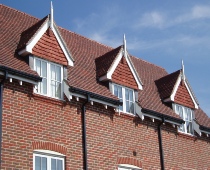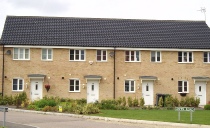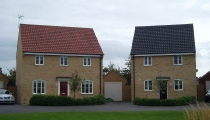




New homes are bad for your health
Why new homes are bad for your health
There are several reasons why living in a new home can be bad for your long-term health. Inadequate levels of natural light, poor design and small living spaces can have a profound adverse effect on a person's health.
A survey found people wanted a home they could relax in, feel safe in and one their children could be happy in. It appears the house builder’s new home designs are not achieving these basic human needs.
A TV documentary on Channel 4 'The Secret Life of Buildings' shown on 1st August 2011 highlighted how the design of new homes can adversely effect a normally healthy person.
Insufficient levels of natural daylight
Many of the windows in new homes are less than half a square metre, about the size of a pizza box. The reason they are so small is to save money for the house builder. Some rooms do not have any windows at all - bathrooms and WCs without windows are now commonplace
A low light level (Lux) affects the internal body clock. Outside, even on a cloudy day, the light level is around 30,000lux. In contrast, the level of light in the average room in today’s new homes is around 200 – 300lux - ten times less than outside.
As part of the TV programme, a person stayed in a reduced light (200lux) home for 7 days. During this time he was asked to record his mood, test his blood glucose levels and take urine samples. In just a week the deterioration in his physical and mental health was quite marked.
Before the experiment his blood glucose levels were 5.77. After 7 days of living in reduced light conditions the reading was 6.87. Anything above 6 is cause for concern and the 6.87 level was at diabetes type 2 levels. It was also confirmed that his internal body clock was already getting out of synchronisation by nearly 1% - this could lead to depression, immune system suppression and diabetes type 2; as well as affecting internal organs such as the digestion system, kidneys and the liver.
The most marked difference was in the person’s mood or mental state. After the experiment, this individual was three times more tense, 90% more depressed and had only 10% of his original vigour and vitality, being twice as tired as he was before the 7 days of reduced light living.
Size does matter! - UK new homes are the smallest homes in Europe
Figures from the Commission for Architecture and the Built Environment (CABE) show that UK house builders construct some of the smallest new homes in Europe. Among common complaints received were small kitchens, lack of room for a sofa in the living room, lack of storage space, overlooking by neighbouring homes, low ceilings, small bedrooms and narrow rooms. The RIBA homewise website and Case for Space Report
 Since 1980, there have been no minimum regulations for space standards for new housing built in England and Scotland.
Since 1980, there have been no minimum regulations for space standards for new housing built in England and Scotland.
In the UK the average room size in a new home is 15.8sqm. In France the average is 26.9sqm - 70% larger. In the graphic you can see that the average UK new home is just a third the size of those built in the US and Australia and just over half the size of a new homes being built in Denmark.
House builders market their new homes based on the number of bedrooms - not in relation to the size of the overall home. Property prices are based on the number of rooms so a small house with more rooms than a larger home will be marketed at a higher price, irrespective of the actual size of the rooms and functionality of the design.
Experiments have been conducted using 3D virtual rooms where dimensions and ceiling heights can be changed to see how the human brain reacts to space. These have shown that a raised ceiling gives a more relaxed state of mind and that a lack of dimension gives rise to feelings of compression, stress and adversely impact on brain function.
House builder's marketing sales tricks
House builders are well aware that the new homes they build are small in comparison to older properties. This is why doors often not fitted in show homes and why show homes are furnished using undersized sofas, beds and chairs; all to give the impression the new homes on offer are larger than they really are. Mirrors are used to give an impression of more space and artificial lighting is always permanently on to fool the new home buyer.
Poor design of new homes
Space around a new home, the position and sense of privacy are also important. People need a private space they can retreat in. Cramped new housing developments which maximise the density, cramming in as many homes as the planners will allow by using multi-storey apartment blocks and terraced townhouses cannot provide this.
House builders are also increasingly making use of roof spaces, especially in narrow town houses. The sloping ceilings and small rooms add to the cramped feeling.
Shape and proportion of rooms
The actual home layout also needs to be properly thought out. There is a 'golden section' a rectangle with sides in a ratio that is universally pleasing to the human eye. The ratio is found in many classic historic buildings as well as in nature. The magic ratio is 1:1618. This is about the same proportion as a piece of A4 paper.

If rooms are sized in proportion to this ratio with windows and other features it will be more pleasing and the home a better design than most of the new home layouts currently being built.
A sound basis for a rational new home design, coupled with a specifying the right materials can make or break a new home. House builders appear preoccupied with maximising their profits, specifying and using the cheapest materials that often don’t last and look and feel 'plastic'. Once the initial magic of a new home wears off owners of brand new homes often find they are living in a home that has not been designed properly and does not suit their lifestyle or needs.




USA - 214
AUSTRALIA - 206
DENMARK - 136
SPAIN - 97
FRANCE - 113
IRELAND - 88
BRITAIN - 76
Average floor area of new homes
- Floor space in square metres
Each rectangle is the golden ratio 1 : 1.618. These are sub-divided by squares to create a new smaller golden ratio rectangle.


1

1.618
| Micro Homes |
| Studio Apartments |
| Apartments |
| Townhouses |
| Mews Houses |
| Terraced Houses |
| Detached Houses |
| Buying an apartment |
| Leasehold Property |
| Considerations when buying a flat |
| Retirement developments |
| Part exchanging |
| New homes can be bad for your health |
| Why buyers avoid new homes |
| Condensing boilers |
| Brownfield land |
| Consumer Code Dispute Resolution |
| Claiming Compensation - Adjudication Scheme |
| Tricks of the showhome |
| Sales advisors and sales centres |
| Timber frame new homes |
| Timber frame - what you need to know |
| Quality issues with timber frame homes |
| Fire and timber frame new homes |
| What the NHBC does |
| New stamp duty calculator |
| Scotland LBTT calculator |
| Removals and moving home |
| Packing and planning the move |
| Checklist for change of address |
| Choosing a mortgage |
| Avoiding mortgage refusal |
| Rules for new home mortgages |
| Help to Buy |
| First Buy |
| New Buy |
| Best Buys |
| Home Insurance |
| How to save on home insurance |
| Home insurance policy conditions |
| Flood insurance claim |
| Renting do's and don'ts |
| Section 106 Agreements |
| Community Infrastructure Levy 2010 |
| Snagging and Quality |
| Why do new homes have defects |
| Professional snagging |
| Snagging research |
| DIY snagging your new home |
| SNAGGING DEFECT PHOTOGRAPHS |
| External DIY snaglist |
| Internal DIY snaglist |
| External snagging defect photo slideshow |
| Internal snagging defect photo slideshow |
| External snagging defects from new homes |
| Who are the best house builders |
| The worst house builders |
| Builder's end of year figures |
| Finding a new home |
| HBF customer satisfaction survey results |
| NHBC awards league table |
| Job Vacancies |
| Persimmon Homes |
| Taylor Wimpey Homes |
| Barratt Homes |
| Bellway Homes |
| Redrow Homes |
| Bovis Homes |
| Berkeley Homes |
| Linden Homes |
| Crest Homes |
| Miller Homes |
| Bloor Homes |
| Taylor Wimpey on BBC Watchdog |
| New home customer satisfaction surveys |
| HBF New home survey results |
| HBF House builder star rating |
| Site Manager |
| Regional Managing Director 1 |
| Regional Managing Director 2 |
| Executive Chairman 1 |
| Executive Chairman final letter |
| NHBC warranty claim |
| Subject Access Request |
| New Home Blog |
| New Home News |
| Latest news |
| News 2011 |
| News 2010 |
| News 2008 |
| News 2007 |
| News 2006 |

